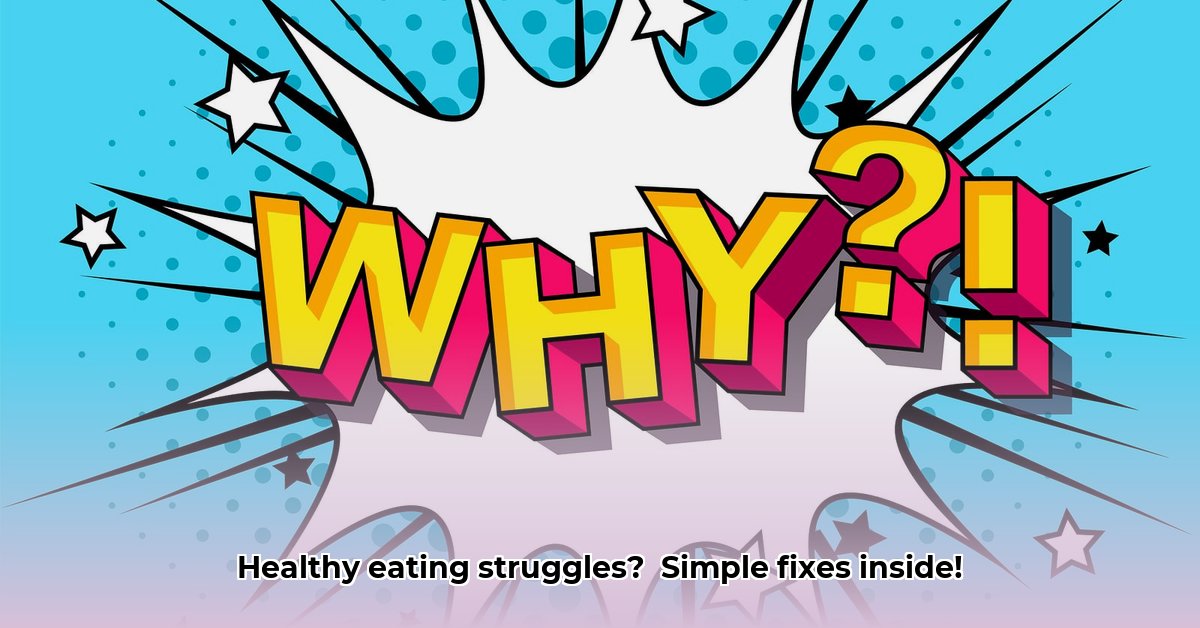Let’s be honest: eating healthy is tough. We all know it’s good for us, but between tempting junk food, confusing nutrition advice, and hectic schedules, it often feels impossible. This isn’t just about lacking willpower; it’s many things working against us – from clever marketing tricks to our bodies and minds. This article is your guide to figuring out why healthy eating is so darn hard and, more importantly, what you can actually do about it. We’ll break down the challenges and give you practical steps to build healthy habits that stick. For more in-depth guidance, check out this helpful resource: healthy eating guide.
Decoding the Difficulty: Why Healthy Eating Feels Like a Chore
Let’s be real: eating healthy feels like climbing a mountain sometimes. We know it’s important, but actually doing it? That’s a different story. It’s not about lacking willpower; it’s a complicated mix of factors that makes maintaining a balanced diet a challenge. What hurdles do we face when trying to achieve a healthier lifestyle?
Navigating Misleading Food Marketing and Overcoming Conflicting Information
One huge reason healthy eating is tough is the constant barrage of food marketing. Companies spend billions making processed foods—the ones packed with sugar, salt, and unhealthy fats—look irresistible. They’re designed to be addictive, making it super hard to say no. Think about the last time you saw a fast-food commercial; it’s engineered to make you crave that burger.
And then there’s the endless flood of confusing diet advice. One day carbs are the enemy, the next it’s fat. It’s enough to leave you feeling lost and frustrated! No wonder so many people find healthy eating a struggle navigating a minefield of misinformation. How can consumers discern fact from fiction in the nutrition world?
- Look for Credible Sources: Rely on registered dietitians, reputable health organizations (like the American Heart Association or Academy of Nutrition and Dietetics), and peer-reviewed scientific studies.
- Be Wary of Trends: Fad diets often make extreme claims and lack scientific support.
- Read Labels Carefully: Pay attention to serving sizes, ingredients, and nutrient content.
Understanding Biases: How Our Bodies Complicate Healthy Choices
Here’s another twist: our bodies are naturally drawn to high-calorie foods. This was essential for survival back when food was scarce, but it’s not so helpful now, when we’re surrounded by calorie-dense, processed goodies. It’s like having an inner voice constantly whispering, “Eat that donut!” This natural craving makes sticking to a healthy diet an uphill battle. Is it possible to rewire our food cravings for better health?
- Understand the Science: Our brains release dopamine (a feel-good chemical) when we eat sugary and fatty foods. This creates a reward cycle that can be hard to break.
- Train Your Taste Buds: Gradually reduce your intake of sugary and processed foods. Over time, your taste buds will adapt, and you’ll start to crave healthier options.
- Focus on Whole Foods: Fruits, vegetables, lean proteins, and whole grains provide essential nutrients and help you feel full and satisfied.
Balancing Act: Addressing Lifestyle Factors Impacting Dietary Choices
Let’s be honest, life throws curveballs. Juggling work, family, and everything else leaves little time for meticulous meal planning and cooking. Healthy food can also be more expensive, especially on a tight budget. This makes healthy eating a privilege for many. And then there’s the emotional side. Stress, anxiety, sadness – we often turn to food for comfort. That’s why we have “comfort food,” right? This emotional connection to food can easily lead to unhealthy eating patterns. It’s a vicious cycle that’s hard to break. Does our environment play a bigger role than we realize in shaping our eating habits?
- Limited Access: Food deserts, areas with limited access to affordable and nutritious food, can make healthy eating incredibly difficult.
- Socioeconomic Factors: Lower-income individuals and families often face greater challenges in accessing healthy food.
- Cultural Norms: Social gatherings and cultural traditions can sometimes revolve around unhealthy foods.
Actionable Strategies: Building a Healthier You, One Step at a Time
So, how do we navigate these challenges? The secret isn’t a drastic diet overhaul, but rather a series of small, achievable steps. By implementing small wins can lead to significant change in our eating habits.
Small Wins, Big Changes:
- Start Small, Think Big: Don’t try to change everything at once. Pick one or two things to focus on. Maybe start by drinking more water and cutting back on sugary sodas.
- Plan Your Attacks (Meal Prep!): Spending a little time prepping meals on the weekend can save you from impulsive unhealthy choices during the week. Think of it as preventative medicine for your waistline.
- Become a Label Detective: Learn to read food labels like a pro. You’ll be surprised how much hidden sugar and unhealthy fats lurk in seemingly harmless foods.
- Build Your Support Squad: Don’t try to do this alone. Lean on friends, family, or even a registered dietitian for support and encouragement. Sharing your journey with others can make all the difference.
- Be Kind to Yourself: Change takes time. There will be slip-ups. Don’t beat yourself up over them. Just acknowledge them, learn from them, and keep moving forward.
Long-Term Progress: Cultivating Enduring Healthy Eating Habits
The key is to create sustainable habits, not quick fixes. Think of healthy eating as a marathon, not a sprint. It’s about progress, not perfection. Prioritizing long-term sustainability can make healthy choices easier for the future.
| Strategy | Short-Term Goal | Long-Term Goal |
|---|---|---|
| Reduce Sugary Drinks | Swap one sugary drink a day for water | Gradually eliminate sugary drinks |
| Increase Fruits & Veggies | Add one serving of fruits or vegetables daily | Aim for at least five servings daily |
| Mindful Eating | Pay attention to your hunger and fullness cues | Develop a mindful eating practice throughout your day |
Remember, everyone faces challenges when trying to eat well. By understanding the obstacles and focusing on making small, sustainable changes, you can build healthy habits that last a lifetime. It’s a journey, not a race. Be patient with yourself, celebrate your successes, and keep learning along the way. There’s still so much to learn about nutrition—research evolves, and new understandings emerge all the time. Keep an open mind and enjoy the process! It’s not about reaching a point where you’re “done” with healthy eating; it’s about continuously learning and adapting.
How to Overcome Psychological Barriers to Sustainable Healthy Eating
Why does healthy eating feel like a constant uphill battle? It’s not always about willpower. Often, it’s about the psychological hurdles we face. Let’s tackle those head-on. What are the main psychological factors that influence our food choices?
Key Takeaways:
- Healthy eating is challenging due to individual, environmental, and systemic factors.
- Small, sustainable changes are more effective than drastic overhauls.
- Addressing psychological barriers—like emotional eating and stress—is crucial.
- Personalized strategies, support systems, and accessible resources are essential.
- Healthcare providers, public health officials, and the food industry all have roles to play.
Identifying Mental Blocks: Understanding the Hurdles
Why is maintaining a healthy diet so tough? It’s not just about willpower; it’s a complex interplay of factors. Think of it like trying to navigate a maze blindfolded– you’re bumping into walls (barriers) you can’t even see. We face individual challenges like time constraints and financial limitations. Then there are environmental factors, like limited access to healthy food options or social pressures that make healthy choices difficult. And finally, systemic issues—the overwhelming amount of conflicting nutrition information—add to the confusion. How can we identify and dismantle the psychological barriers preventing us from adopting healthier habits?
Time Management: Tackling Time Constraints
Let’s face it: Life gets busy. But you don’t need hours in the kitchen. Here’s how to make healthy eating fit your schedule. Can strategic planning make healthy eating more accessible and less stressful?
- Batch cooking: Prepare large portions on the weekend for quick meals during the week. For example, roast a whole chicken or cook a big pot of soup.
- Meal prepping: Chop veggies, cook grains, or portion out snacks in advance. Store them in containers for easy grabbing.
- Embrace convenience: Utilize frozen fruits, vegetables, and pre-washed salads. They’re just as nutritious as fresh options and save you time.
Budget-Friendly Choices: Conquering Financial Limits
Eating healthy doesn’t have to break the bank. What affordable strategies can make healthy eating accessible to those on a tight budget?
- Plan your meals: Create a weekly grocery list based on affordable, healthy ingredients. This helps prevent impulse purchases.
- Buy in bulk: Stock up on staples like grains and beans when they’re on sale.
- Cook at home: Eating out is significantly more expensive than home-cooked meals.
- Choose seasonal produce: Fruits and vegetables are
- How Glass Bento Box Containers Make Meal Prep Easier - December 18, 2025
- Why Glass Boxes for Lunch Are Trending for Meal Prep - December 17, 2025
- Bento Box Glass Offers Practical, Eco-Friendly Meal Storage - December 16, 2025










